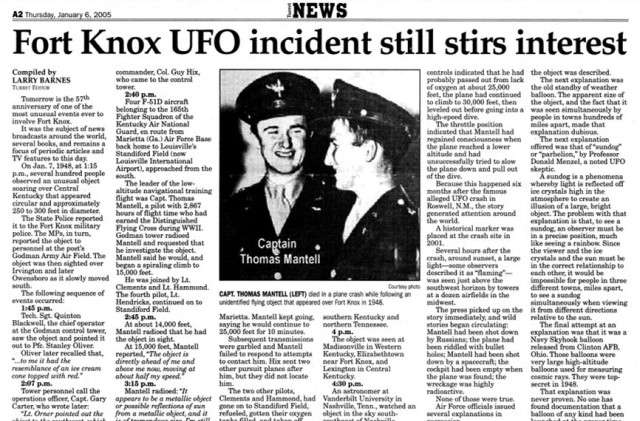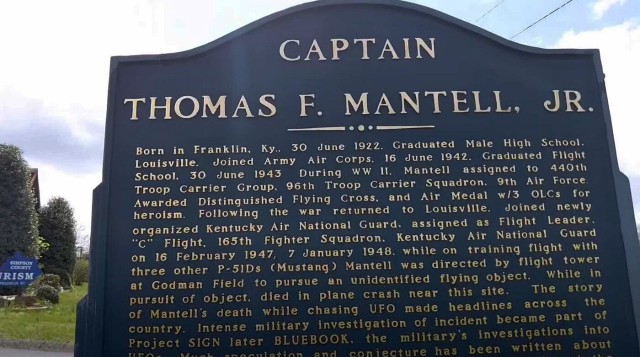Questions remain 75 years after mysterious Fort Knox UFO incident, downed pilot
FORT KNOX, Ky. — His 2,867 flight hours, much of it in combat, and Distinguished Flying Cross and four Air Medals weren’t enough to avoid a fatal crash near a Franklin, Kentucky farm.

Exactly 75 years later, Capt. Thomas Mantell’s flight that afternoon still remains shrouded in mystery. He died while pursuing a UFO that was seen in the skies over Godman Army Airfield by countless people throughout the region surrounding Fort Knox.
On Jan. 7, 1948, Mantell sat in the cockpit of his F-51D Mustang as flight leader headed north from Marietta Air Force Base in Georgia back to Louisville’s Standiford Field. He and three other pilots from the Kentucky Air National Guard’s Flight C, 165th Fighter Squadron had been participating in a low-altitude navigational training exercise when the request came from Godman Commander Col. Guy Hix to investigate the sightings.
The 25-year-old World War II hero acknowledged the request, and he and two other pilots climbed to 15,000 feet to intercept it. The fourth, a “Lt. Hendricks”, continued on to Standiford Field.
According to a Jan. 6, 2005 article by Turret editor Larry Barnes, several hundred people in Central Kentucky had already witnessed the UFO by 1:15 p.m. on that Wednesday, a day described by some observers as partly cloudy with high-altitude feathery cirrus clouds. That day is recorded by Wunderground.com as also having relatively calm winds, mild temperatures — a high of 49 degrees — zero precipitation, and visibility for at least 10 miles.
“It would have been probably a typical winter day. If they had cirrus clouds in the sky, the visibility would have been great,” said an area weather forecaster. “There was just nothing much else going on weatherwise, so it probably made for a pretty good day.”
News agencies wasted no time turning the crash into front-page news. The big questions on everyone’s minds: What did Mantell encounter, and why did he crash?
The Debrief.org website reveals the mad scramble for answers in its Feb. 15, 2022 story by Jazz Shaw titled “What was Pilot Thomas Mantell Chasing When His Plane Crashed in 1948?” Reporting on source materials from Project BLUEBOOK, Shaw notes that Air Materiel Command at Wright-Patterson Air Force Base in Ohio requested meteorological records shortly afterward of the region from that particular day.
“They also asked astronomers to identify the positions of both Venus and Jupiter in the sky on an hourly basis,” writes Shaw. “They definitely seemed to be looking for any mundane explanation, but even their own investigation found that those planets would not be visible during daylight hours and the weather was good for visibility.”
Later theories that Mantell had merely seen Venus in the sky when he described what he witnessed were debunked as a result. But he wasn’t the only one to see the phenomenon.
Calls came into Kentucky state police offices from concerned Kentuckians at several different locations throughout the morning and early afternoon; so many, in fact, that officers decided to alert the Fort Knox military police, who in turn notified personnel at Godman as the object slowly traveled south from Irvington to Owensboro before reaching Godman.
Some at Godman had already observed the object by 1:45 p.m. as it traveled over Fort Knox.
Two tower personnel, Tech Sgt. Quinton Blackwell and Pfc. Stanley Oliver, later described the mysterious object as something resembling an ice cream-filled cone or parachute — white and round on top with a conical shape underneath. Operations officer Capt. Gary Carter said the round white object was plainly visible in the afternoon sky.
At 2:45 p.m., Mantell radioed the tower that he had spotted the object at 14,000 feet. At 15,000 feet, he provided an update: “The object is directly ahead of me and above me now, moving at about half my speed.”
Thirty minutes later, Mantell offered an update: “It appears to be a metallic object or possible reflections of sun from a metallic object, and it is of tremendous size. I’m still climbing. The object is above and ahead of me moving at my speed or faster. I’m trying to close in for a better look.”
In Barnes’ story, the other two pilots — Clements and Hammond — turned back at 22,000 feet due to a lack of oxygen because their airplanes weren’t equipped with it, likely because of the type of training mission they had been performing. They returned to Standiford Airfield to refuel and get oxygen masks.
Meanwhile, Mantell continued the pursuit, radioing at roughly 3:30 p.m. that he would fly about 10 more minutes to around 25,000 feet.
As they arrived at Standiford, the tower recorded Clements saying the object “appears like the reflection of sunlight on an airplane canopy.” By 3:50 p.m., Godman Tower reported that they had lost sight of the object. Ten minutes later, sightings began to come in from neighboring communities to the south of Fort Knox.
After a few more garbled transmissions, communications with Mantell ceased. By 5 p.m., debris from his airplane was discovered in Shelby County, southeast of Louisville. Investigators noted that his seatbelt had been shredded.
His watch had stopped at 3:18 p.m.
According to Chapter 3 of the National Investigations Committee on Aerial Phenomena report, the Air Force’s initial assessment was that Mantell had been pursuing Venus, since another incident eerily similar had occurred a few months before in which the pilot thought Venus was a UFO. However, the meteorological records didn’t support that assessment.
Reporters around the world fanned the flames of the UFO theory, concluding that Mantell had been shot down by aliens who felt threatened. The crash happened six months after the famous UFO crash at Roswell, New Mexico, which led many to again believe in the existence of aliens.
Air Force Investigators eventually concluded, based on the position of the throttle and the crash debris, that Mantell had likely suffered from oxygen deprivation and passed out at around 25,000 feet. The aircraft continued to climb to 30,000 feet, before leveling off and eventually taking a high-speed nosedive to the earth.
Many suspect that what Mantell pursued in 1948 was a Navy Skyhook balloon released from Clinton Air Force Base, in Ohio. Part of a highly classified program known as Project Skyhook that operated during the same timeframe as the Roswell and Fort Knox incidents, the balloons were huge high-altitude devices used to gather intelligence and information.
According to the David Darling website, the Navy would launch the balloons partially inflated, which would cause them to slowly inflate the higher they rose. At maximum size, they would swell to 600 feet high and 100 feet in diameter, climbing to an altitude of 60,000 feet.
The site claims that the balloons were the likely culprit for Mantell’s demise.
However, there still exists no documentation to prove or disapprove this theory. And other accounts suggest that one of Mantell’s garbled last transmissions claims he saw people sitting inside the flying object and that his airplane burst into flames before striking the ground.

Placed at the site of Mantell’s crash in 2001, a historical plaque remains in Franklin just off I-65 — the same town of his birth — along with unanswered questions.
This article has been archived for your research. The original version from United States Army can be found here.


